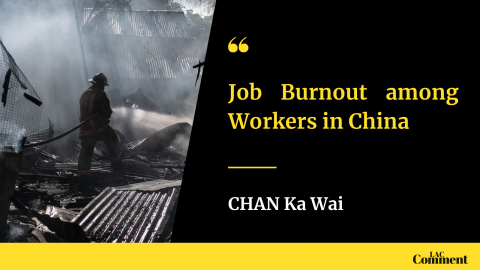Fri, 04/09/2021 - 18:31 — lac-admin

2021-04-09

CHAN Ka Wai
Labour Action China
April 9, 2021
During the COVID-pandemic, medical professionals have faced great pressure at work. It is same to cleaning workers who need to work for 10-12 hours every day. Both groups are regarded as the highly risky groups in exposure of the virus. Both professionals and grassroots workers suffer from job burnout. But job burnout is not limited to happen to specific workers in specific places. It rather prevails among workers in different works, including manufacturing, medical, professional, services, mining, etc.
In China, job burnout has been seen as one of the severe occupational diseases and has attracted serious academic attention. But regrettably, it is much more limited in the medical profession. They take job burnout as an issue of public health and inclines to reduce the issue to personal adjustment to the risks of burnout.
Medical academics also point out the occupational environmental risks and make recommendations to the business to prevent, reduce or eliminate the risks of job burnout. But it is just recommendations, not legal requirement. The Chinese Government has not hitherto taken actions to review and revise the labour regulations in order to protect mental well-being of workers.
1. Mental distress at work among miners
There is an ironic report on a study on life quality of the copper-nickel miners of a mining enterprise in Xinjiang [1]. The study focuses on the two units: mining and ore dressing. These two groups may be the most labouring and difficult parts in the whole mining.
The result is interesting. The indexes of most items of physical health of the workers are better than the normal standard in China except body pain. But the indexes of all the items of mental health are under the normal standard. Mining is a labouring-intensive work. Mining workers’ physical health is assumed generally to be worse than that of common workers. Poor physical health brings bad mental health too. But the research tells us something different. Yes, the workers’ mental health is poor but their physical health is not. In other words, their poor mental health does not result from poor physical health. If the research really reveals the truth, it implies that the issue of mental distress at work is more complicated than what we thought before. The study does not provide us more information for discussion of the factors of mental distresses of the workers.
Another finding is also interesting. Higher educated or older the workers are, more mental distresses they suffer. It is in our common sense that older workers suffer more mental distresses because they are more physically unfit to the work and then are worried more about the job security.
But why do the higher educated suffer too? One study cannot tell us many things, but it does challenge our common beliefs on mental health at work. The problems are much beyond our knowledge.
2. Job burnout among administrative and professional staffs
Another research on burnouts of workers in Shenzhen and Guangzhou, Guangdong also tells us that job burnout prevails among administrative and professional staffs in two Chinese modern cities. The research studies the workers of two similar-scaled enterprises in Shenzhen and Guangzhou respectively [2]. Majority of them have senior high education or above and serve as administrative and professional staffs.
In terms of the seriousness of burnout (normal: <4), 59.2% of the workers’ burnout index in the Guangzhou enterprise are higher than 4, and 53.93 %, in the Shenzhen enterprise. In the Guangzhou enterprise, 56.6% of the workers suffer insomnia and 24.2% are suspected to suffer insomnia. In the Shenzhen enterprise, 53.2% of the workers suffer insomnia and 23.7% are suspected to suffer insomnia.
In the Guangzhou enterprise, 22.5% and 31.2% of the workers are classified as moderately and highly risky on mental health, respectively. In the Shenzhen one, 22.9% and 31.2% are classified as moderately and highly risky on mental health, respectively. The workers as mentally highly risky persons are outweighed in comparison of the workers as mentally moderately risky ones. On mental health, the workers in both enterprises are in a dangerous situation and suffer serious burnout at work.
Job burnout causes the workers emotional exhaustion, low morale and low motivation to work. Business is worried about productivity of workers, but we care of their health.
Mental distress at work is popular among the workers who work in very labouring works, such as miners, but also among administrative and professional staffs. Mental distress at work has become a common occupational disease today.
Notes:
[1] Xue Qiaoyun, Ge Hua & Liu Jiwen, “Investigation on the Life Quality of Copper-nickel Miners and Its Influencing Factors” (Chinese), Journal of Xinjiang Medical University, Vol. 14, No.11 (Nov 2018), pp.1334-1337.
[2] Jiang Fan, Qiu Chang, Zeng Ling-yun, et.al., Comparison and Correlation Analysis between the Status of Job Burnout and Sleep, Fatigue and Mental Health” (Chinese), Journal of Neuroscience and Mental Health, Vol. 15, No.2 (2015), pp.122-125.
* The author owns the copyright. It is prohibited to reprint this article without the author's permission.
議題聚焦:
